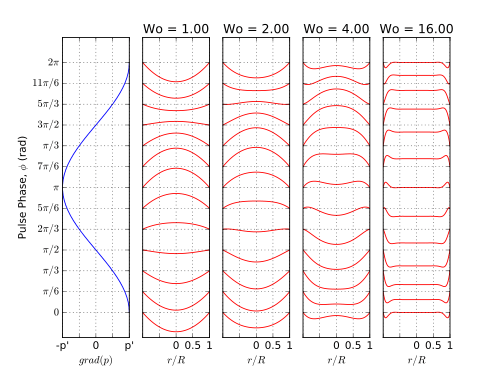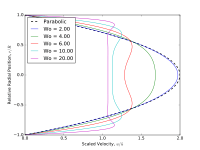Pulsatile flow
In fluid dynamics, a flow with periodic variations is known as pulsatile flow, or as Womersley flow. The flow profiles was first derived by John R. Womersley (1907–1958) in his work with blood flow in arteries.[1] The cardiovascular system of chordate animals is a very good example where pulsatile flow is found, but pulsatile flow is also observed in engines and hydraulic systems, as a result of rotating mechanisms pumping the fluid.
Equation

The pulsatile flow profile is given in a straight pipe by
where:
u is the longitudinal flow velocity, r is the radial coordinate, t is time, α is the dimensionless Womersley number, ω is the angular frequency of the first harmonic of a Fourier series of an oscillatory pressure gradient, n are the natural numbers, P'n is the pressure gradient magnitude for the frequency nω, ρ is the fluid density, μ is the dynamic viscosity, R is the pipe radius, J0(·) is the Bessel function of first kind and order zero, i is the imaginary number, and Re{·} is the real part of a complex number.
Properties
Womersley number
The pulsatile flow profile changes its shape depending on the Womersley number
For , viscous forces dominate the flow, and the pulse is considered quasi-static with a parabolic profile. For , the inertial forces are dominant in the central core, whereas viscous forces dominate near the boundary layer. Thus, the velocity profile gets flattened, and phase between the pressure and velocity waves gets shifted towards the core.
Function limits
Lower limit
The Bessel function at its lower limit becomes[2]
which converges to the Hagen-Poiseuille flow profile for steady flow for
or to a quasi-static pulse with parabolic profile when
In this case, the function is real, because the pressure and velocity waves are in phase.
Upper limit
The Bessel function at its upper limit it becomes[2]
which converges to
This is highly reminiscent of the Stokes layer on an oscillating flat plate, or the skin-depth penetration of an alternating magnetic field into an electrical conductor. On the surface , but the exponential term becomes negligible once becomes large, the velocity profile becomes almost constant and independent of the viscosity. Thus, the flow simply oscillates as a plug profile in time according to the pressure gradient,
However, close to the walls, in a layer of thickness , the velocity adjusts rapidly to zero. Furthermore, the phase of the time oscillation varies quickly with position across the layer. The exponential decay of the higher frequencies is faster.
Derivation
For deriving the analytical solution of this non-stationary flow velocity profile, the following assumptions are taken:[3][4]
- Fluid is homogeneous, incompressible and Newtonian;
- Tube wall is rigid and circular;
- Motion is laminar, axisymmetric and parallel to the tube's axis;
- Boundary conditions are: axisymmetry at the centre, and no-slip condition on the wall;
- Pressure gradient is a periodic function that drives the fluid;
- Gravitation has no effect on the fluid.
Thus, the Navier-Stokes equation and the continuity equation are simplified as
and
respectively. The pressure gradient driving the pulsatile flow is decomposed in Fourier series,
where is the imaginary number, is the angular frequency of the first harmonic (i.e., ), and are the amplitudes of each harmonic . Note that, (standing for ) is the steady-state pressure gradient, whose sign is opposed to the steady-state velocity (i.e., a negative pressure gradient yields positive flow). Similarly, the velocity profile is also decomposed in Fourier series in phase with the pressure gradient, because the fluid is incompressible,
where are the amplitudes of each harmonic of the periodic function, and the steady component () is simply Poiseuille flow
Thus, the Navier-Stokes equation for each harmonic reads as
With the boundary conditions satisfied, the general solution of this ordinary differential equation for the oscillatory part () is
where is the Bessel function of first kind and order zero, is the Bessel function of second kind and order zero, and are arbitrary constants, and is the dimensionless Womersley number. The axisymetic boundary condition () is applied to show that for the derivative of above equation to be valid, as the derivatives and approach infinity. Next, the wall non-slip boundary condition () yields . Hence, the amplitudes of the velocity profile of the harmonic becomes
where is used for simplification. The velocity profile itself is obtained by taking the real part of the complex function resulted from the summation of all harmonics of the pulse,
Velocity profile

To compare the shape of the velocity profile, it can be assumed that
where
is the shape function.[5] It is important to notice that this formulation ignores the inertial effects. The velocity profile approximates a parabolic profile or a plug profile, for low or high Womersley numbers, respectively.
Wall shear stress
For straight pipes, wall shear stress is
The derivative of a Bessel function is
Hence,
Centre line velocity
If the pressure gradient is not measured, it can still be obtained by measuring the velocity at the centre line. The measured velocity has only the real part of the full expression in the form of
Noting that , the full physical expression becomes
at the centre line. The measured velocity is compared with the full expression by applying some properties of complex number. For any product of complex numbers (), the amplitude and phase have the relations and , respectively. Hence,
and
which finally yield
See also
- Cardiovascular system
- Hemodynamics
- Womersley number
- Fluid hammer
References
- Womersley, J.R. (March 1955). "Method for the calculation of velocity, rate of flow and viscous drag in arteries when the pressure gradient is known". J. Physiol. 127 (3): 553–563. doi:10.1113/jphysiol.1955.sp005276. PMC 1365740. PMID 14368548.
-
Mestel, Jonathan (March 2009). "Pulsatile flow in a long straight artery" (PDF). Imperial College London. Retrieved 6 January 2017.
Bio Fluid Mechanics: Lecture 14
- Fung, Y. C. (1990). Biomechanics – Motion, flow, stress and growth. New York (USA): Springer-Verlag. p. 569. ISBN 9780387971247.
- Nield, D.A.; Kuznetsov, A.V. (2007). "Forced convection with laminar pulsating flow in a channel or tube". International Journal of Thermal Sciences. 46 (6): 551–560. doi:10.1016/j.ijthermalsci.2006.07.011.
- San, Omer; Staples, Anne E (2012). "An improved model for reduced-order physiological fluid flows". Journal of Mechanics in Medicine and Biology. 12 (3): 125–152. arXiv:1212.0188. doi:10.1142/S0219519411004666.